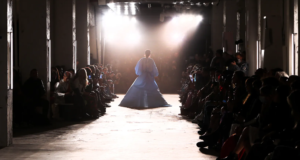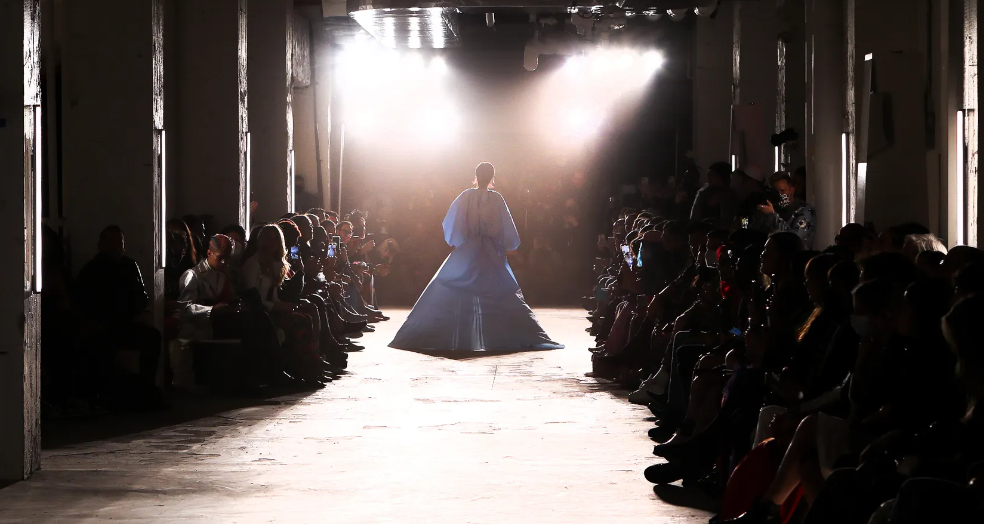
It’s been six months since Kim Kardashian informed the world that she lost 16 pounds in three weeks in order to fit into Marilyn Monroe’s dress for the Met Gala. For me, it marked a shift in tone, a proverbial Kardashian in the coal mine, ushering in the end of an era that at least claimed to celebrate curvy bodies.
It would be unfair to wholly blame one celebrity’s diet for this paradigm shift, but Kardashian’s weight loss is not the only crack in the veneer of body inclusion. I see those fractures in the repeated emphasis on quote-unquote getting your body back post-pandemic; the plus-size lines that have been pulled or the promise of expanding sizes that simply never came; and more recently, the return of Y2K fashion, a style synonymous with low-rise jeans and thinness. The aspirational body was moving on from thick thighs, hourglass curves, and the so-called BBL-era—a time when plastic surgery was used to add curves instead of taking them away, long before Kardashian shimmied up the steps of The Met with Monroe’s dress clinging to her new slimmer figure. (To be clear: that standard was still an unattainable ideal, but it was when we saw increased representation and celebration of larger bodies).
After New York Fashion Week, many plus-size writers and influencers wondered where the representation had gone. The Fashion Spot releases a seasonal report on diversity at the shows and has seen that since spring 2016 size inclusivity has steadily increased, peaking in the spring 2020 season with 68 plus-size models appearing in shows (accounting for about 5% of total castings). The spring 2023 analysis has yet to be released. Still, a lack of diversity was certainly felt, and the sensation only intensified during the European shows.
While certain body shapes coming in and out of style is nothing new, the whiplash I feel somehow caught me off guard. Aren’t we tired of this yet? Surely there are enough trends to chase that my body doesn’t have to be one of them.
For the last decade my body briefly stopped being a liability. I’ve seen steady progress in the arena of body acceptance, from increased designer size ranges (Abercrombie’s plus-size line is a stark departure from the brand’s public distaste for plus-size customers in 2006) to more mainstream adoption of Health at Every Size (a movement to deprioritize a patient’s weight in medical contexts) to the fashion-idol status awarded to plus-size celebrities (Lizzo, Aidy Bryant, and Jennifer Coolidge to name a few). These all previously felt impossible.
WATCH
Everything You Need to Know About the Miniskirt From the 1960s to Now
Now suddenly I find myself thrust backward. I’m left wondering what this backslide means for the fashion industry; for the fat liberationists whose cries for change went beyond surface-level self-love to fighting for workplace rights that still aren’t enshrined in law; and for the younger generation who are about to learn what it’s like being fat in a time of thin worship.
For Gianluca Russo, the author of The Power of Plus, this regression of body diversity was inevitable and follows the same pattern of plus-size fashion in the ’90s, a movement that died down during the early aughts only to be revived by social media in 2010. The ’90s introduced the world to one of the first plus-size supermodels, Emme, and saw the launch of brands like Ashley Stewart and Torrid. Rosie O’Donnell had a successful daytime show, and Queen Latifah was making the pivot from music to movies.
Conversely, the Y2K era was marked by the rise of public fat shaming, ranging from tabloid body checking to full movie plot points (lest we forget Samantha’s body shaming in the Sex and the City movie) and a distorted definition of what plus-size meant. (I will remain forever haunted that America Ferrera was routinely cast as a fat and unattractive character). There was a significant reported increase in eating disorders between 2000 and 2009. “From Hollywood to the runways of New York Fashion Week, we’re seeing a current emphasis put on thinness as the optimal trend,” Russo says. “You can see that from celebrity weight loss to the models sent down the runway, and that’s really scary for these young people who are going to then internalize these messages, whether they realize it or not, because the body image is going to be shaped by everything they’re taking in just as it was for us.”
This idea of generational impact is one echoed by Kimberly Nicole Foster, a cultural critic and YouTuber, who noted the increased harm for those with intersectional identities. “There’s a renewed pressure that I am seeing, feeling, hearing—a familiar pressure to cut calories, to get thinner, to worry, Is my butt too big? Are my thighs too big? Am I eating too much? And I think for Black women who have that particular body type, it’s hurtful to be cast aside after these years of body celebration,” says Foster.
She goes on to highlight that while a Kardashian might be able to afford surgery, meal plans, and trainers to change their body, many people, including the Black women who have repeatedly served as an inspiration for the Kardashian empire, aren’t able to so easily chase the trend of a new body. “There’s a lot of women who invested time and money in chasing that unattainable ideal, and it’s going to be particularly jarring that the rewards for having that body are no longer going to be available to you because that’s no longer the beauty standard,” Foster says.
Loft announced on Instagram last year that it would no longer be offering sizes above an 18; Canadian plus-size retailer Addition Elle closed in 2020; and it took less than a year from the August 2021 launch of Old Navy’s splashy plus-size in-store Bodequality initiatives to announce plans to scale back. This shift away from large brands investing resources into plus-size inclusion and expansion is something Nicolette Mason, a plus-size consultant and strategist, confirms she’s also seeing. “Expanding sizing is a very expensive endeavor,” Mason says. “Can brands afford it? Probably, but that’s almost beside the point when they’re focused on their bottom line, and customer acquisition is such an expensive endeavor. I do not think this is the right approach, but a lot of brands—rather than continuing to invest in customer acquisition, creating awareness, creating a great fit and product for a newer segment of customers than they’ve historically catered to—are instead reverting back to focusing all of their resources on their existing customer base where they know they can make money.”
So is there a path forward for those of us who still hold out hope that diminishing plus representation on the runway doesn’t automatically equate to fewer plus-size designer clothes hanging in our closet? Relying on the plus community was unanimously the answer.
“As disheartening as it is to say that we have to put in more work ourselves, if we want to keep seeing change, that’s what we’re going to have to do because designers simply do not care enough yet,” Russo says, emphasizing that it is up to the plus community to show support for those brands making our sizes.
Mason reiterated this sentiment, reminding us that, yes, shopping size-inclusive brands is important but so is sharing that brand with your friends, engaging on social media, or even simply signing up for their newsletters. For smaller businesses, those actions have an impact on their ability to grow, scale, and fundraise. Finally, Mason notes if you do have the size privilege to shop anywhere, being intentional to support brands that have larger size ranges can be a make-or-break factor in giving that business the ability to continue producing in larger sizes as well.
And for those of us feeling the familiar internal twinge of body resentment and apprehension, Foster calls to the social community as a tool of body assurance. “My hope is that young women are going to be able to find and invest in communities on these platforms where they might be able to find some respite,” she says. “If we’re going to resist this body-diversity regression, then we’re going to have to be so intentional about coming together to resist.”
For me, I’m finding joy in the fragments of progress I’m still seeing: James Corbin walking at London Fashion Week; Berriez’s New York Fashion Week show that featured models ranging from straight sizes to a 26/28; the experience of trying on plus clothing in person at stores like Ganni, Mara Hoffman, and Wray; and the fact that I own a pair of perfectly fitting plus-size Abercrombie jeans. Most of all, I have the grounding knowledge that, unlike when I was 17 crying over the differences between my body and Paris Hilton’s, I now have platforms where I can keep fighting for fat fashion.

